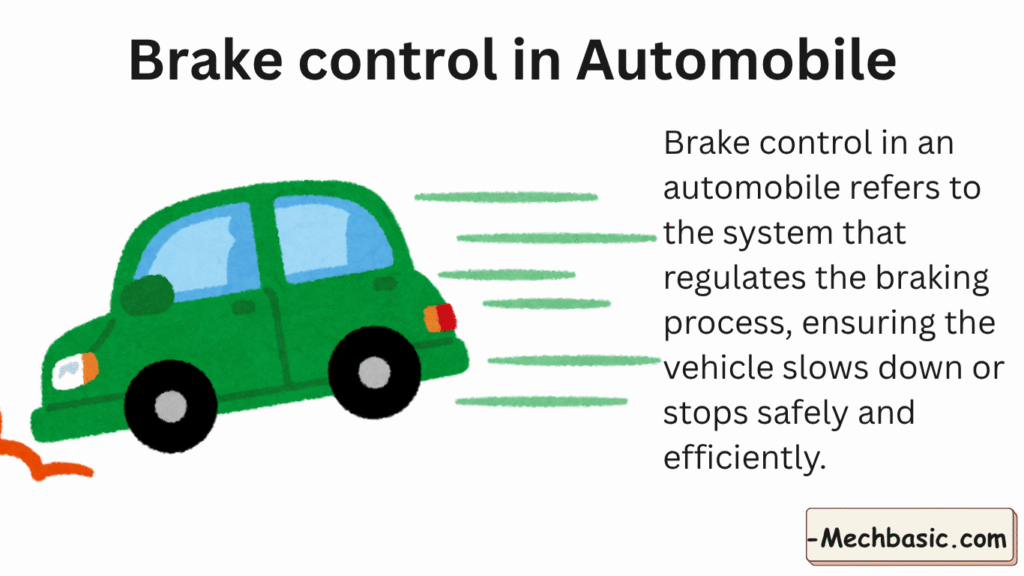Let’s go in detail about brake control in an automobile:

In this article:
1. What is Brake Control?
Brake control in an automobile refers to the system that regulates the braking process, ensuring the vehicle slows down or stops safely and efficiently.
- Modern cars use mechanical, hydraulic, and electronic systems to control brakes.
- Brake control includes driver input (pedal), hydraulic mechanisms, and electronic systems like ABS and EBD.
2. Purpose of Brake Control
- Stop the Vehicle Safely: Ensures the car comes to a halt within a reasonable distance.
- Prevent Skidding or Loss of Control: Systems like ABS prevent wheel lockup on slippery surfaces.
- Balance Braking Force: Distributes braking between wheels for stability.
- Enhance Driving Comfort: Smooth braking reduces jerks and vibrations.
- Integration with Other Safety Systems: Works with traction control, stability control, and collision avoidance systems.
3. Types of Brake Control in Vehicles
A. Conventional Hydraulic Brakes
- Uses brake fluid to transmit force from the pedal to brake calipers or drums.
- Components:
- Brake pedal
- Master cylinder
- Brake lines
- Brake calipers / wheel cylinders
- Limitation: Wheels can lock up under hard braking.
B. Anti-lock Braking System (ABS)
- Prevents wheel lockup during sudden braking.
- Components:
- Wheel speed sensors
- ABS control module
- Hydraulic modulator
- How it works: Detects wheel lock and modulates brake pressure to maintain traction.
C. Electronic Brake-force Distribution (EBD)
- Adjusts brake force between front and rear wheels based on load and road conditions.
- Improves vehicle stability during braking, especially with uneven passenger/cargo load.
D. Brake Assist (BA)
- Detects emergency braking (quick pedal press) and applies maximum braking force automatically.
E. Electronic Parking Brake (EPB)
- Replaces traditional handbrake with electronic control.
- Can be activated by a switch; automatically holds the car on slopes.
F. Regenerative Braking (in EVs/Hybrids)
- Uses electric motor to slow the vehicle, converting kinetic energy into electric energy stored in the battery.
- Works together with hydraulic brakes for complete braking.
4. Components of Brake Control Systems
| Component | Function |
|---|---|
| Brake Pedal | Driver input to initiate braking |
| Master Cylinder | Converts pedal force into hydraulic pressure |
| Brake Lines | Transmit hydraulic pressure to brakes |
| Brake Calipers / Wheel Cylinders | Apply force to brake pads/shoes to stop wheels |
| Brake Pads / Shoes | Create friction to slow/stop wheels |
| ABS Sensors & Module | Prevent wheel lockup and maintain traction |
| Electronic Modules (EBD, BA, EPB) | Optimize brake force distribution and assist driver |
5. How Brake Control Works
- Driver presses brake pedal → force transmitted to master cylinder.
- Hydraulic pressure travels through brake lines → activates calipers or wheel cylinders.
- Brake pads/shoes create friction → slows down or stops wheels.
- ABS/EBD modules monitor wheel speed and load → modulate pressure if needed to prevent skidding or maintain stability.
- Feedback loop ensures safe and effective braking under all conditions.
6. Advantages of Modern Brake Control
- Improved Safety: ABS and EBD prevent skidding and loss of control.
- Shorter Stopping Distance: Brake Assist applies maximum force in emergencies.
- Load-Adaptive Braking: EBD adjusts for cargo/passenger weight.
- Convenience: Electronic parking brakes simplify hill starts and parking.
- Integration with Advanced Systems: Works with traction control, adaptive cruise, and collision avoidance.
✅ Summary
- Brake control = system that regulates vehicle braking for safety, efficiency, and stability.
- Modern vehicles use hydraulic, electronic, and regenerative systems.
- Key technologies: ABS, EBD, Brake Assist, EPB, and regenerative braking.
- Sensors and electronic modules monitor vehicle conditions and optimize braking in real time.
💡 Tip:
Regular brake maintenance (pads, fluid, sensors) is critical because even with advanced brake control, worn or faulty components reduce effectiveness and safety.
Other courses:



